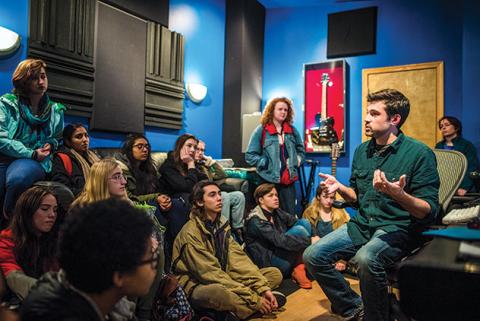Course's Focus: Waves of Power
Anthropologist has found sound as worthy of study as text or images.

Anthropology professor Amanda Weidman ’92—whose research has focused mainly on music, media, and performance in South Asia—has in recent years broadened her interest beyond traditional notions of music.
“From the chants of protesters to the hum of engines, from the ring of church bells to the background tracks of our favorite songs, sound matters. It is not just a background to what we see, but a crucial and powerful part of social life. Sound, whether produced deliberately or as a byproduct of other activities, has effects which are often tangible, material, and political.”
That’s how Weidman introduces Waves of Power: The Anthropology and Cultural Politics of Sound, offered for the first time this past fall.
“A lot of researchers in ethnomusicology and related fields are starting to leave aside ‘music’ as a framework and think instead about the broader concept of sound,” says Weidman. “Using sound as a category is very freeing. It allows you to talk about music in ways that recognize its social and political embeddedness.”
Weidman wanted students to realize that sound is just as worthy of academic study as written texts and visual images, but she also made sure that, along with that intellectual content, the course had practical components.
“For part of the class, we’re thinking about, reading about, and writing about sound. And for the other part, we’re working with sound—recording it, editing it, and making a piece that says something through the medium of sound,” explains Weidman.
The biggest surprise for Weidman was her students’ creativity in producing the sound projects she assigned. One student recorded the sound of the treadmill she was working out on and showed how the machine’s various pitches were a sonic expression of such culturally salient issues as the obsession with fitness and body image.
Some students used sound recording as a medium for ethnographic documentation, and others focused on how sound recordings are constructed to give a sense of reality. One recorded the sounds of services at two synagogues to explore how the differences in Orthodox and Reform Judaism were reflected in the contrasting sounds. Another used the final project to construct a natural- sounding soundscape and then deconstructed it piece by piece.
“When you teach a course for the first time, it’s experimental, and it’s interesting to see what students come up with,” says Weidman.
“They’ve given me ideas for how I might guide the class the next time.”
Surround Sound
“Sound is there; it’s shaping us all the time,” says Weidman, “but we don’t often pay much attention to it or treat it in an intellectual way.”
Required Reading
Matt Sakakeeny’s Roll With It looks at New Orleans brass bands and the tension between the musicians’ sonic claims to urban space and their exploitation by the tourist industry.
Noise vs. Sound
“We had talked about noise as a constructed category and the fact that what’s thought of as noise and what’s thought of as a good sound is always a political, social, and cultural matter.”
Japanoise
When UC Santa Barbara Professor David Novak, who has written an ethnography of Japanese “noise music,” visited the class, students were asked to consider how noise
can challenge assumptions about “good” and “bad” sounds.
Published on: 03/17/2017
